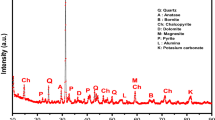Abstract
Based on the studies into ionic—dispersion compositions of sewage water after mining and processing of niobium ore of the Lovozero deposit, it is substantiated to be expedient to convert some pollution agents from solution to suspension state. A combined process is proposed for treatment of mine wastewater, which is 94% of total sewage water of mining and processing, by integrating coagulation, sorption and flotation techniques. The mathematical model of aggregation of suspension particles with regard to the hydrodynamic mode of coagulation is suggested. The model makes it possible to predict material and dispersion compositions of a new multi-phase system under different temperatures towards automation of the wastewater treatment process. The solution on forming surface properties of activated aqueous dispersions of air using a modified finely dispersed sorbent with intent to intensify the wastewater purification process.
Similar content being viewed by others
References
Gershenkop, A.Sh., Skorokhodov, V.F., Sulimenko, L.P., and Kreimer, L.L., Intensification of Waste Water Purification Processes, GIAB, 2000, no. 31, pp. 167–170.
Mesyats, S.P. and Ostapenko, S.P., Estimation of Contents and State of Niobium in Wastewaters Generated by Rare Metals Processing at the Lovozero Deposit for Substantiation of Purification Method, GIAB, Special Issue, 2014, no. 12, pp. 20–27.
Mesyats, S. and Ostapenko, S., Substantiation of Sorption Method for Removing Niobium from Sewage Water after Rare-Metal Ores Processing, Int. Multidisciplinary Scientific GeoConference SGEM, 2016, Book 5, Vol. II, pp. 783–790.
Vlasov, K.A., Kuzmenko, M.V., and Es’kova, E.M., Levozerskii shchelochnoi massiv: porody, pegmatity, mineralogia, geokhimia i genezis (Levozero Alkaline Massif: Rocks, Pegmatites, Mineralogy and Origin), Moscow, AN SSSR, 1959.
Ivanov, V.V., Ekologicheskaya geokhimiya elementov (Ecological Geochemistry of Elements: Reference Book), vol. 5: Rare d-Elements, Moscow, Ekologia, 1997.
Deblonde, G.J., Moncomble, A., Cote, G., Bélair, S., and Chagnes, A., Experimental and Computational Exploration of the UV-Visible Properties of Hexaniobate and Hexatantalate Ions, RSC Advances, 2015, 5 (10), pp. 7619–7627.
Deblonde, G.J., Moncomble, A., Cote, G., et al., RSC Adv., 2014, pp. 1–3; RSC Adv., 2015, no. 5, pp. 64119–64124.
Nyman, M., Polyoxoniobate Chemistry in the 21st Century, Dalton Trans, 2011, no. 40, pp. 8049–8058.
Klemperer, W.G., and Marek, K.A. An 17O NMR Study of Hydrolyzed Nbv in Weakly Acidic and Basic Aqueous Solutions, Eur. J. Inorg. Chem, 2013, pp. 1762–1771.
Wang, X., Zheng, S., Xu H., and Zhang, Y. Leaching of Niobium and Tantalum from a Low-Grade Ore Using a KOH Roast-Water Leach System, Hydrometallurgy, 2009, 98, pp. 219–223.
Huang, P., Qin, C., Su, Z.-M., et al., Self-Assembly and Photocatalytic Properties of Polyoxoniobates: Nb24O72, Nb32O96, and K12Nb96O288 Clusters, J. Am. Chem. Soc., 2012, 134 (34), pp. 14004–14010.
Jin, L., Zhu, Z.K., Wu, YL., et al., Record High-Nuclearity Polyoxoniobates: Discrete Nanoclusters Nb114, Nb81, and Nb52, and Extended Frameworks Based on Cu3 Nb78 and Cu4 Nb78, Angew. Chem. Int. Ed., 2017, 56(51), pp. 16288–16292.
Gartman, T.N. and Klushin, D.V., Osnovy komp’yuternogo modelirovania khimiko-tekhnologicheskikh protsessov (Fundamentals of Computer Modeling of Chemical-Technological Processes: Textbook for Colleges), Moscow: Akademkniga, 2006.
Eremin, E.N., Osnovy khimicheskoi kinetiki (Basic Principles of Chemical Kinetics), Moscow, Vyssh. Shkola, 1976.
Lukashev, E.A., Moiseev, A.V., and Draginsky, V.L., Formation, Growth and Disintegration of Coagulant Flakes during Treatment of Natural Water. Mathematical Reconstruction of Process Flow, Teor. Prikl. Probl. Servisa, 2004, no. 4, pp. 37–46.
Romanovsky, B.V., Osnovy khimicheskoy kinetiki (Basic Principles of Chemical Kinetics), Moscow, Ekzamen, 2006.
Babenkov, E.D., Influence of Water MixingoOn Physical Parameters of Coagulated Suspension, Khim. Tekhnolog. Ochist. Vody, 1980, vol. 2, no. 5, pp. 387–391.
Mel’nikov, N.N, Skorokhodov, V.F., Mesyats, S.P., and Ostapenko, S.P., RF patent no. 2320548, Byull. Izobret., 2008, no. 9.
Author information
Authors and Affiliations
Corresponding author
Additional information
Original Russian Text © V.F. Skorokhodov, S.P. Mesyats, V.V. Biryukov, S.P. Ostapenko, 2018, published in Fiziko-Tekhnicheskie Problemy Razrabotki Poleznykh Iskopaemykh, 2018, No. 4, pp. 161–170.
Rights and permissions
About this article
Cite this article
Skorokhodov, V.F., Mesyats, S.P., Biryukov, V.V. et al. Treatment Technology for Niobium—Bearing Ore Processing Wastewater of Various Ionic-Dispersion Compositions. J Min Sci 54, 671–680 (2018). https://doi.org/10.1134/S106273911804459
Received:
Revised:
Accepted:
Published:
Issue Date:
DOI: https://doi.org/10.1134/S106273911804459




